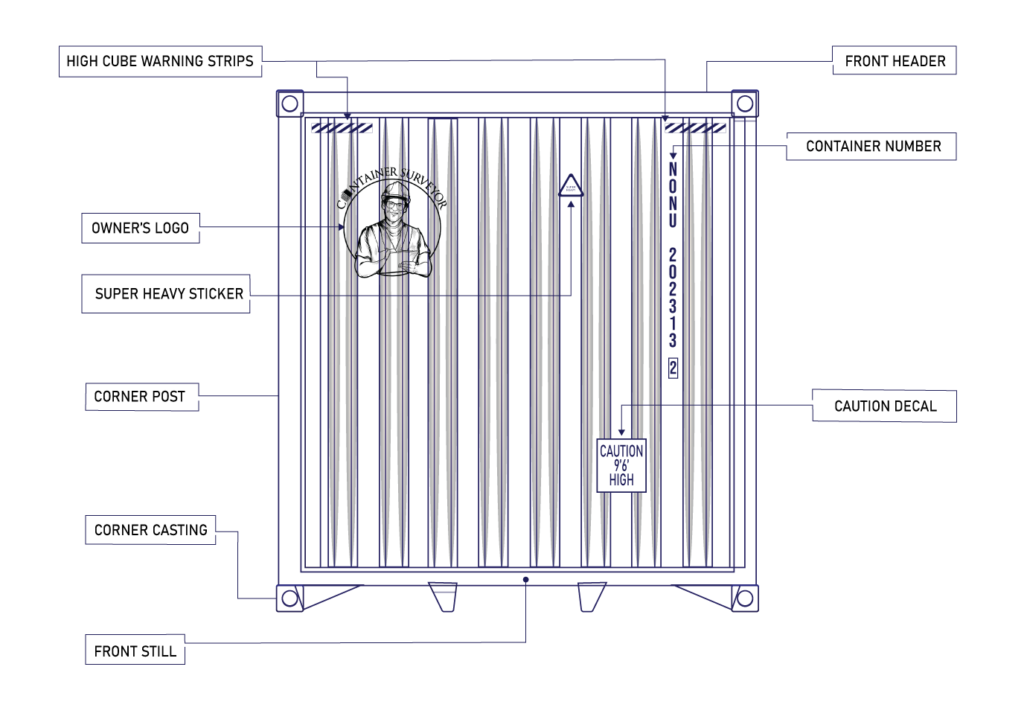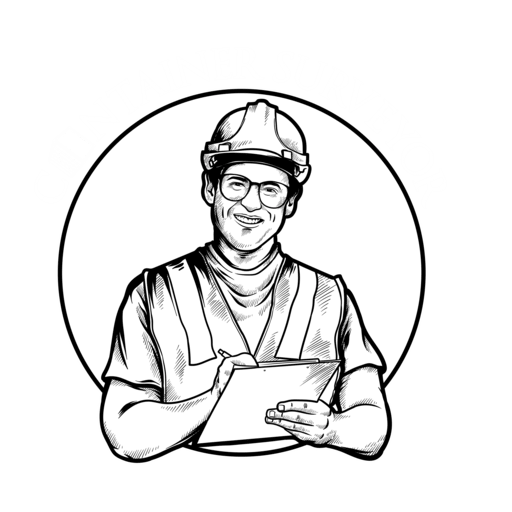Anatomy of a Shipping Container is composed of a corten steel frame, and shipping containers are one of the most well-built, durable structures in the world. And this article explains the structural anatomy of shipping containers.
Table of Contents
Front End Frame
The shipping container front end frame is the corten steel structural assembly at the front end or opposite the door end (rear end) of the container consisting of a transverse front header, front sill (front top and bottom rail) joined at the front corner fittings (corner castings) to the front corner posts; between the front-end frame members, there is an end wall composed, in other words, the front panel.
On the exterior side of the front panel, the owner’s prefix and serial number, including check digit (container no), owner’s logo, caution mark, super heavy sticker, and high cube warning, can be seen on the front panel.

| Note: – Caution mark, super heavy sticker, and high cube warning strip cannot be seen on 20’GP & 40’GP containers. And some 40’HC containers’ high cube warning strips are displayed on the left and right corners of the front header. |
Anatomy of a Shipping Container Rear End Frame
Another Anatomy of a Shipping Container is rear end frame also includes the corten steel structural assembly at the rear end (door end) or opposite the front end of the container consisting of the transverse rear header (rear top rail). The rear sill (rear bottom rail) joined at the rear corner fittings to the rear corner posts from the door opening. At the rear of the container are two doors, and the following components can be seen on the doors. J-Bar, Consolidated data plate (CSC Plate), Door Gaskets Assembly, Handle catch, Handle Retainer.
Hinges, Holdback cord, Locking Bar, locking bar brackets, locking bar cams, locking bar guides, door handles and door stop. The rain gutter is attached to the rear header.
Moreover, labels, decals and markings can be seen on the door panels are classification society mark, owner’s logo, warning/handling instructions, owner’s prefix, and serial number, including check digit (Container no), size and type, weight panel, Repair recommendation, height warning labels, manufacturer details label, manufacturer’s label, super heavy sticker, other labels and stickers.
The door header consists of four cam keepers and high cube warning marks, and the door sill also consists of four cam keepers.


| Note: – caution mark, super heavy sticker, high cube warning cannot see on 20’GP & 40’GP containers |
Shipping Container Side Panel / Sidewalls
Both front and rear end frames connected through the longitudinal structural members of the top side rails and bottom side rails at the top and bottom edge of each side of the container and joined the corner fittings (corner castings) of the end frames. Between the front-end and rear-end frame members, a side wall is composed and known as a side panel.
Owner’s prefix and serial number, including check digit (container number), size and type code, the owners’ logo, super heavy sticker, IC decal, and height decal. Caution decals, high cube warning strips and ventilators can be seen on both sides of the corrugated side panels.

| Note: – caution mark, super heavy sticker, high cube warning strip cannot see on 20’GP & 40’GP containers and some 40’HC container’s high cube warning strips displayed on sides of top side rails. |
Anatomy of a Shipping Container – Roof Panel
The roof of the shipping container has corrugated roof panels welded to the top side rails and at the front and rear headers of the container. The front and rear headers have extension plates on the roof, and a corner protection plate (corner fittings) is on the header extension plates in each corner.
The owner’s prefix and serial number, including check digit (container numbers), super heavy sticker and high cube warning labels, can be seen on the top of the container.

| Note: -, super heavy sticker, high cube warning decal cannot see on 20’GP & 40’GP containers |
Anatomy of a Shipping Container – Under structure
An assembly consisting of bottom side rails, transverse rear sill and front sill, cross members and forklift pocket members, Threshold plate, Floor centre rail/hat section. However, in 40’ft containers, additionally, it has a gooseneck tunnel, outriggers, and tunnel bolster on the front bottom side of the container.
Floorboards are usually made of plywood, fixed by floor screws, and supported by bottom side rails, rear and front sills, cross members and forklift pockets. In a 40’ft container, floorboards are supported by bottom side rails, front and rear sills, cross members and outriggers. The tunnel plate also can be seen in the front bottom side of the container.


Key Shipping Container Parts & Structural Components
Disclaimer: The views expressed by the authors in this article do not necessarily reflect the views of CONTAINER SURVEYOR. Data and charts, if utilized, in the article have been sourced from available information and have not been authenticated by any statutory authority. The author and CONTAINER SURVEYOR do not claim it to be accurate nor accept any responsibility for the same. The views constitute only the opinions and do not constitute any guidelines or recommendation on any course of action to be followed by the reader.


